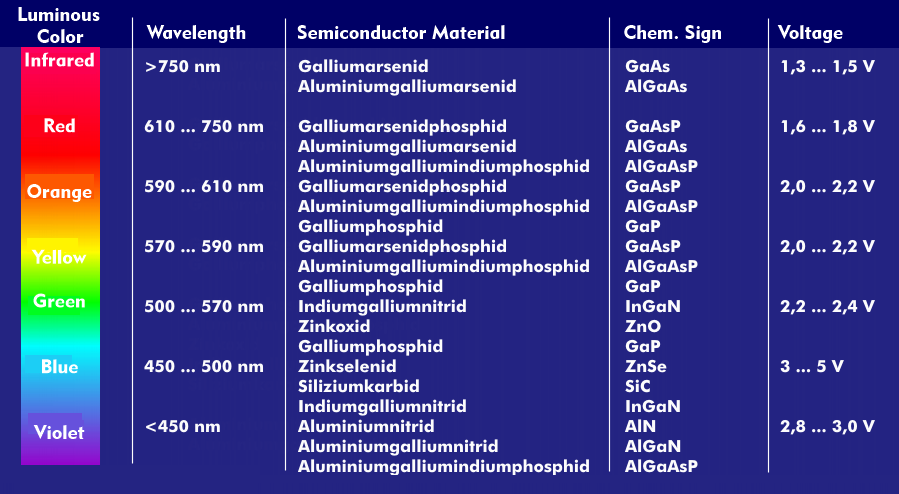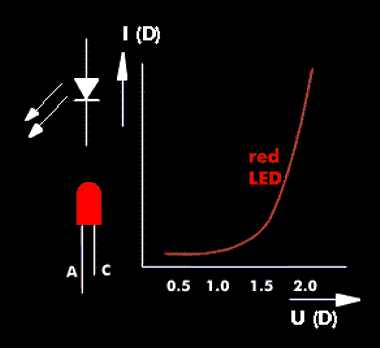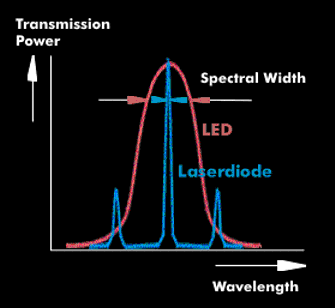light emitting diode (LED)
A light-emitting diode or luminescent diode (LED) is a semiconductor component of optoelectronics that emits light according to the principle of electroluminescence. The electroluminescent diode converts energy supplied by electric current directly into light. This refers to the ability of semiconductors to displace electrons with simultaneous emission of photons. This occurs by an electron or quantum jump from one shell of the Bohr atomic model to another. A quantum jump always occurs with absorption or emission of the energy difference.
In the quantum leap and the associated transition from a higher to a lower energy level, energy is released in the form of a photon. The process of reciprocal absorption of energy and later return to the original state with emission of light (photons) is called luminescence.
Semiconductors from the 3rd and 5th groups of the periodic table are used for this photon emission. They are the III-V compound semiconductors. These are nitrates like gallium nitride( GaN) or indium nitride (InN), phosphides like gallium phosphide (GaP) or arsenides like gallium arsenide( GaAs) or indium arsenide (InAs). These semiconductors or combinations of them determine the color of the light emission.
Because the light spectrum of light-emitting diodes is relatively narrow-banded, the light emission is always colored. A white LED emitting white light can be replicated by tri-color LEDs with additive color mixing of red, green and blue emitting LEDs, or by combining a blue emitting light emitting diode with a yellow phosphor. Additive color mixing of blue and yellow results in white. The color temperature is about 5,600 Kelvin. There are also light-emitting diode arrays with adjustable color temperature that can produce daylight of 6,500 Kelvin.
LED applications: Optical transmission technology, status displays, displays and printers, automotive and lighting technology.
Light-emitting diodes, like laser diodes, are used in communications as a light source for transmission in optical media, and also as status indicators, in LED displays, in lighting technology and in automotive technology. Important characteristic values of light emitting diodes are the luminous flux and the characteristic values for color and brightness perception summarized in the bin code. Further characteristic values are the luminousefficacy, the efficiency and the LED lifetime.
LEDs used in optical transmission technology have a radiation area between 50 µm and 100 µm and above. They are therefore primarily used in multimode fibers. Since the radiation is larger than the core glass area, LED launch is referred to as overfilled launch( OFL). LEDs have some inertia in optical signal generation due to their switching hysteresis. They can be used at data rates up to 100 Mbit/s. They are not suitable for high bit rate applications such as those found in 10 Gigabit Ethernet. Corresponding data rates are covered by VCSEL lasers.
Characteristics and applications of LEDs
LEDs based on the semiconductor gallium arsenide (GaAs) emit light at a wavelength of 850 nm. However, they are also available in other dopants for wavelengths at 1,300 nm and 1,500 nm. Typical output powers are 1 mW, and coupling losses are -17 dB.
Light-emitting diodes produce diffuse (incoherent) light emitted in a relatively wide beam range between 40 degrees and 90 degrees. The spectral window width is 70 nm and can be modulated with modulation frequencies up to about 250 MHz. The pulse rise times that can be generated are 1 ns, which limits its use at transmission rates of 1 Gbit/s.
Energy efficiency and color rendering of LEDs
Light-emitting diodes are also being developed for the backlighting of LCD displays and are increasingly being used as power LEDs for the LED lighting of homes, stores, halls and automotive technology in the form of LED luminaires, LED spotlights and LED headlights. The high-intensity LEDs already available have lighting efficiencies of over 150 lumens per watt and luminous efficacies of up to 8,000 cd/m2. In terms of brightness, these values are already in the range of a 20 W halogen lamp. In addition, the color rendering index( CRI) is 95 and higher, making them ideally suited for lighting living spaces. Depending on the cooling system, their service life is between 50,000 and 100,000 hours, by which is meant the period after which the brightness has dropped to 70% or 50% (depending on the manufacturer) of the initial brightness.
In addition to the classic standard design, there are also SMD LEDs, Surface Mounted Device (SMD) and COB LEDs, Chip on Board (COB), which are characterized by better heat dissipation and higher performance values. Further developments of LEDs include Organic Light Emitting Diodes( OLED), Polymeric LEDs( PLED), UV LEDs, which are used in UV surface treatment, and AC LEDs for room lighting, which can be connected directly to the power grid. Infrared LEDs( IR LEDs), from which visible light LEDs have emerged, should also be mentioned in this context. In addition to monochromatic LEDs, there are also bicolor and tricolor LEDs, bi-color LEDs and tri-color LEDs.


-Foto-Philips.png)

